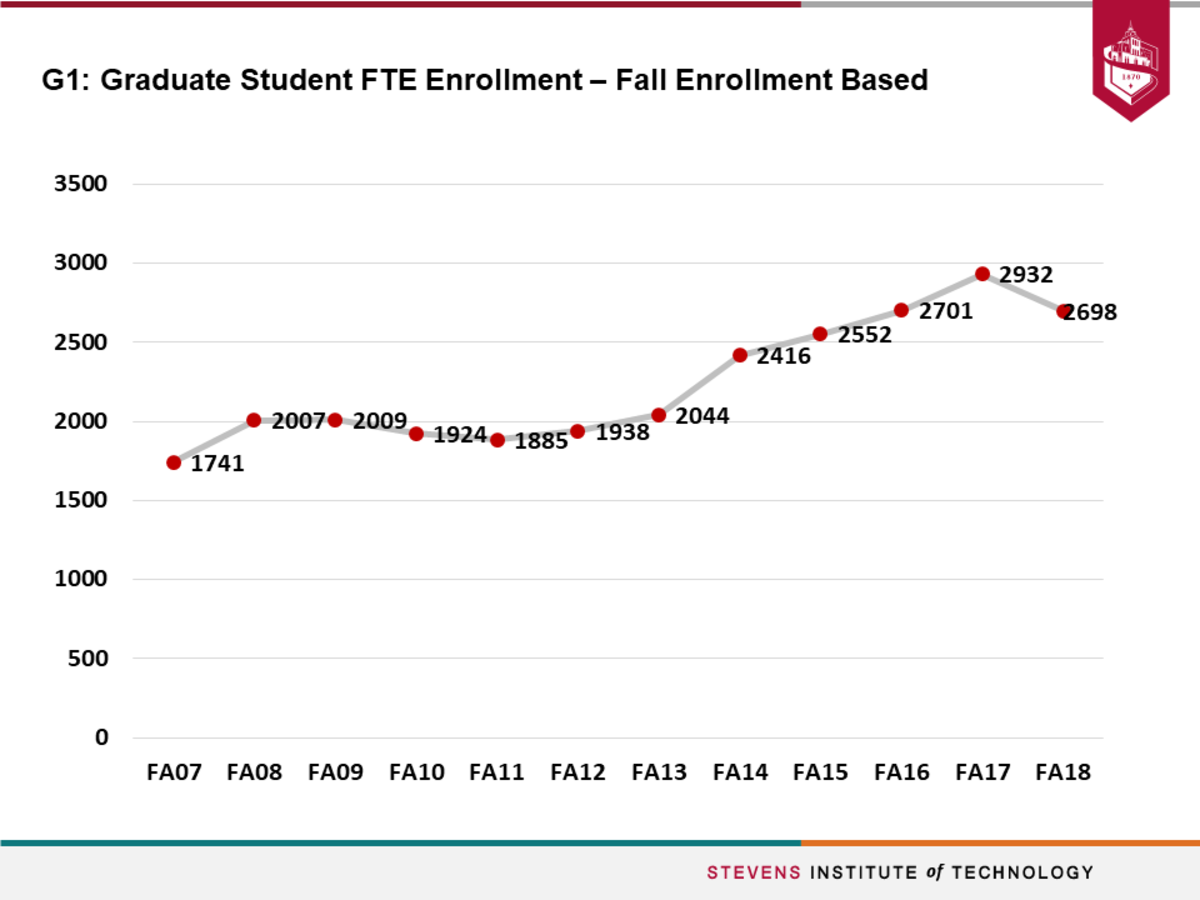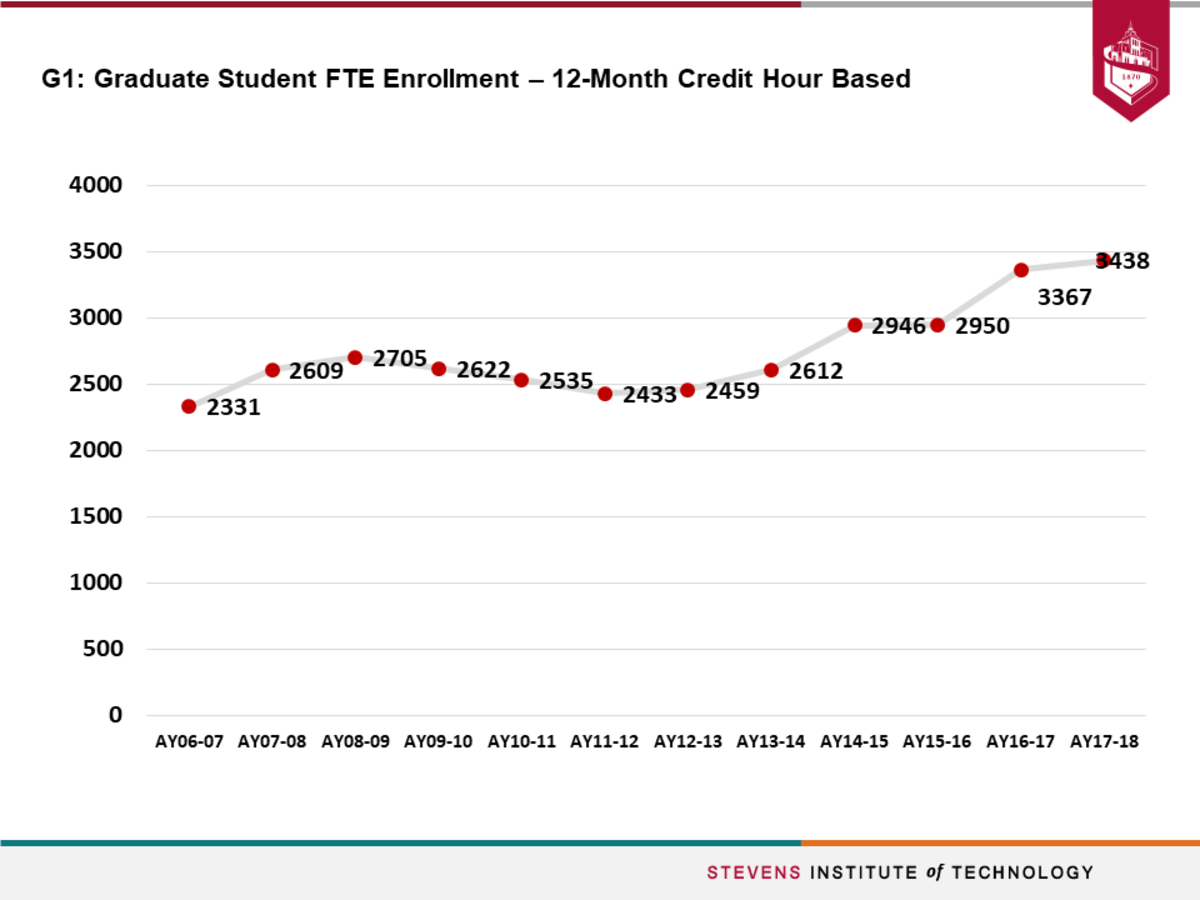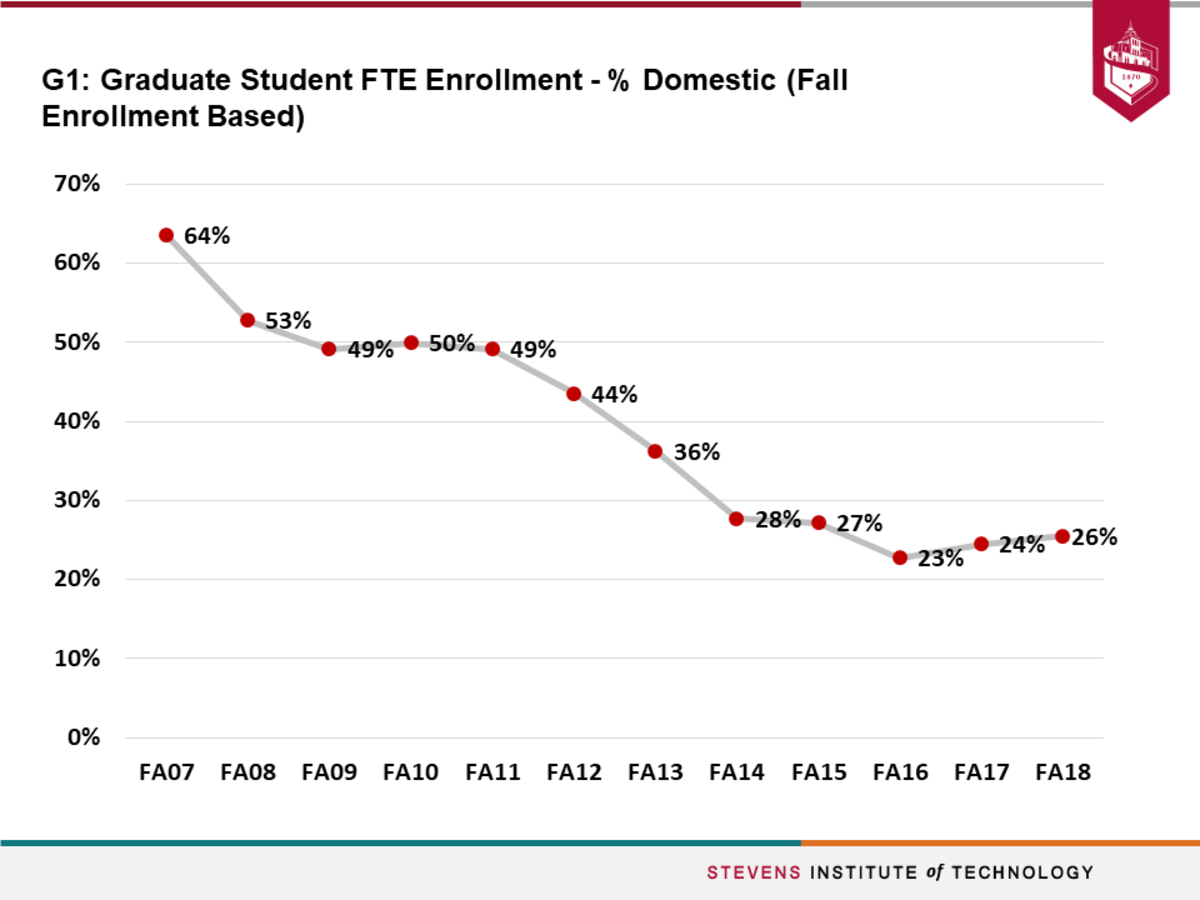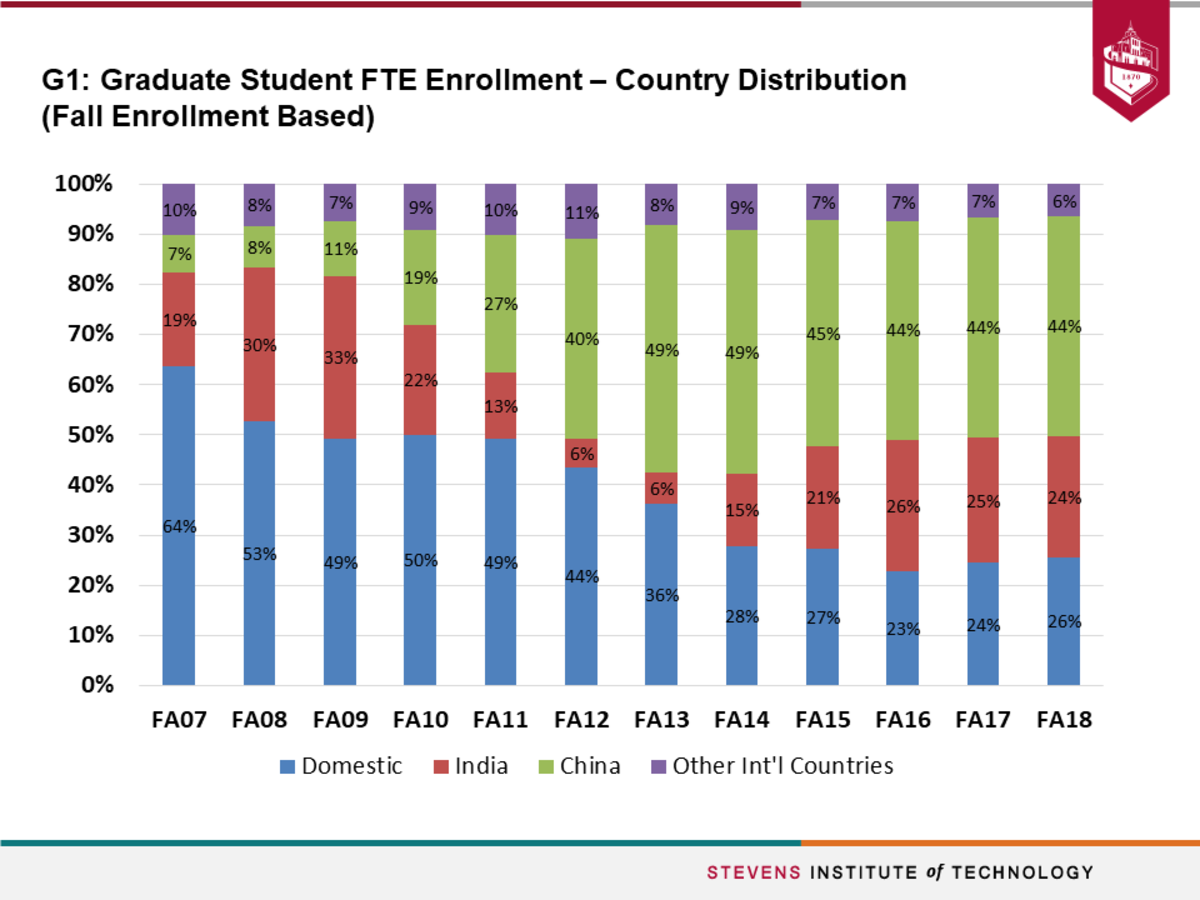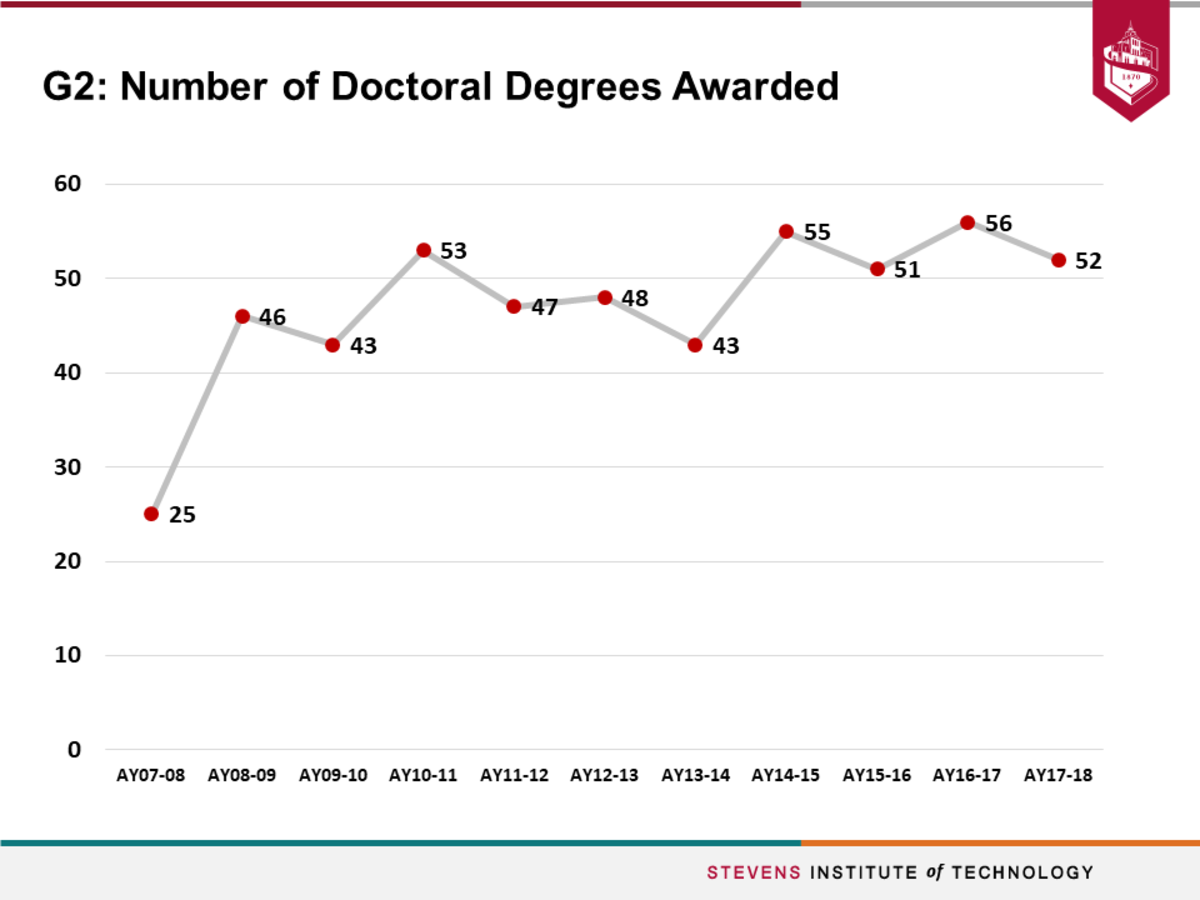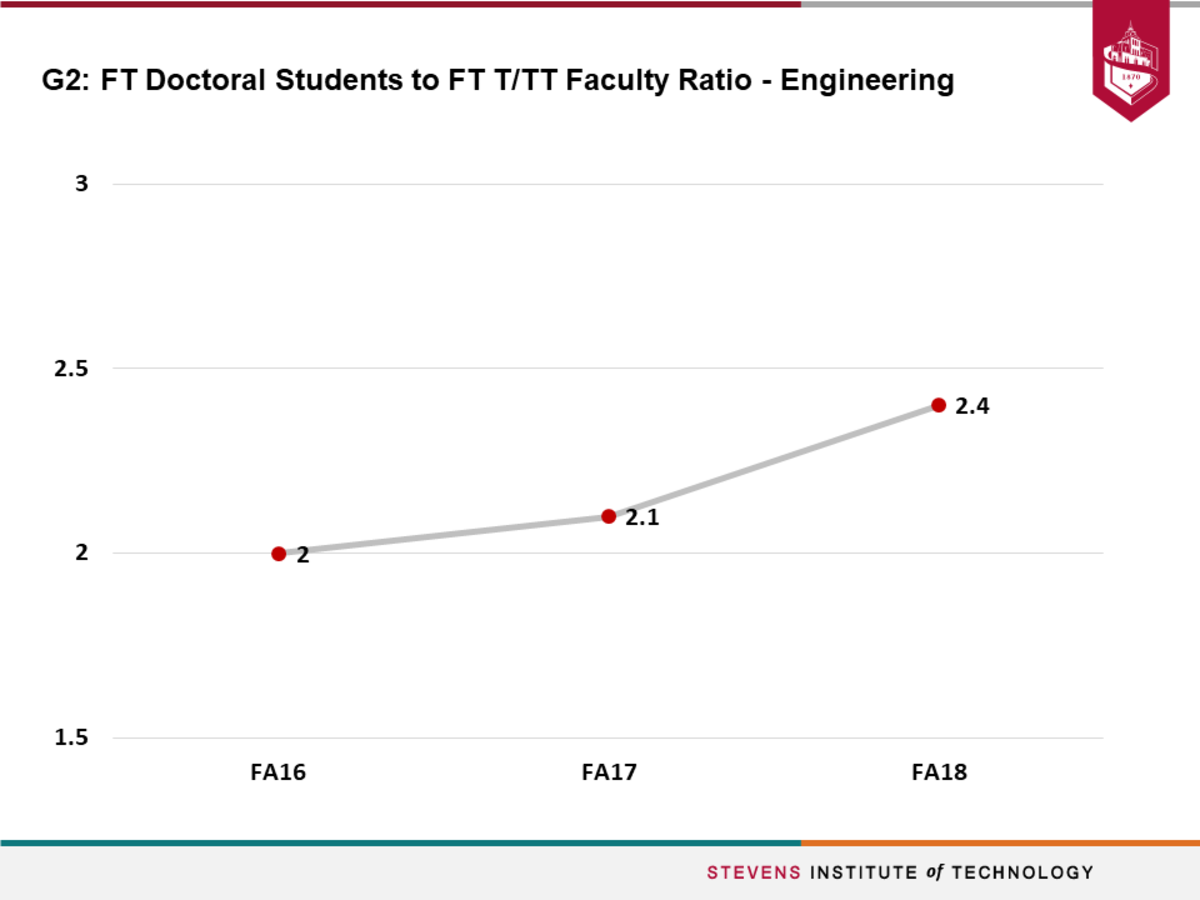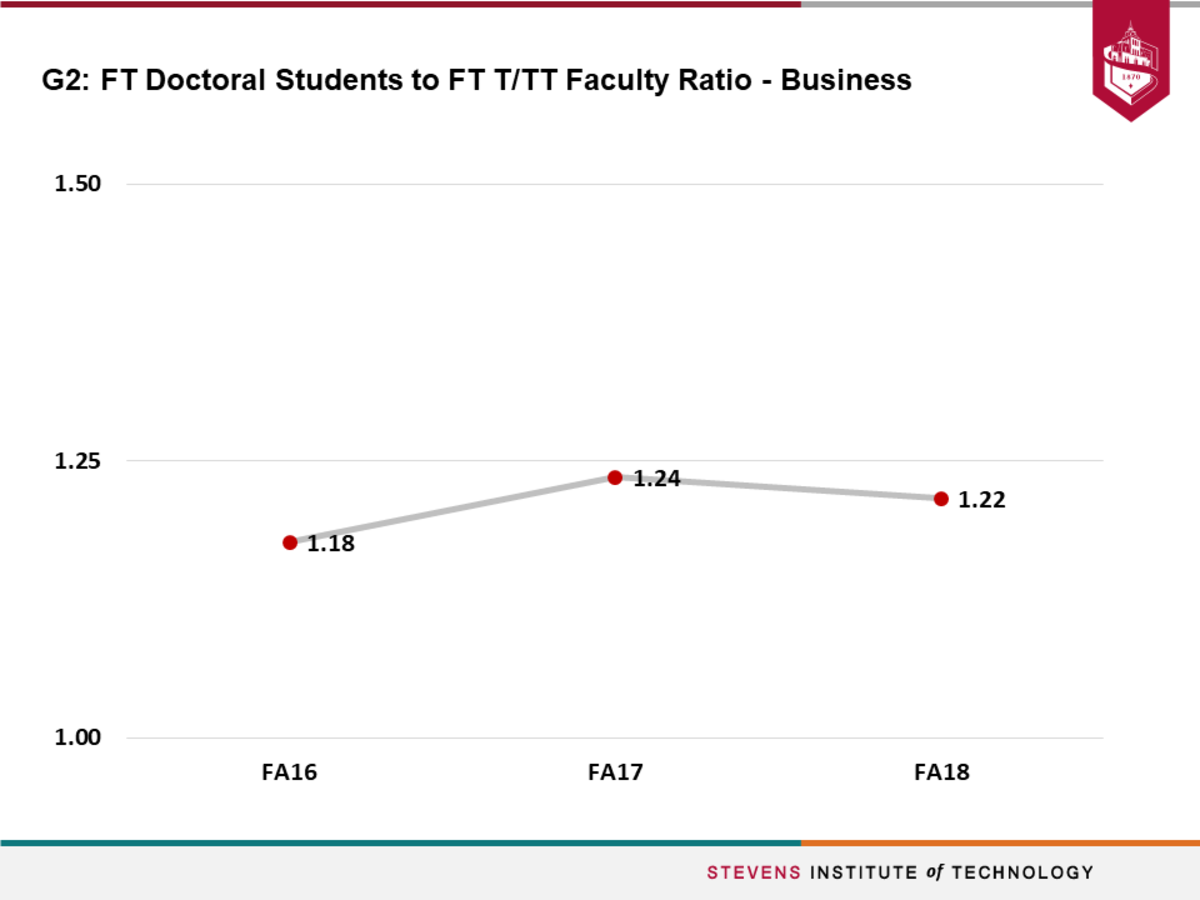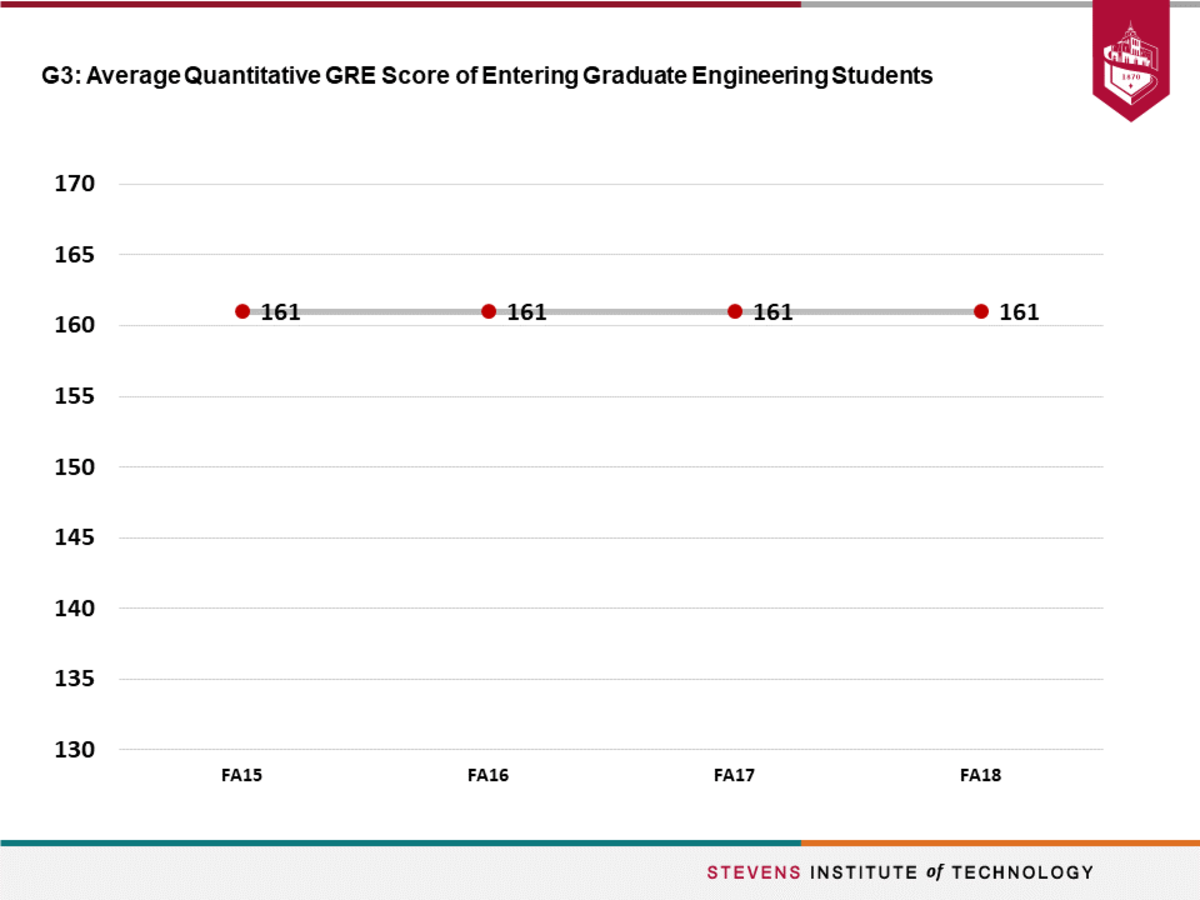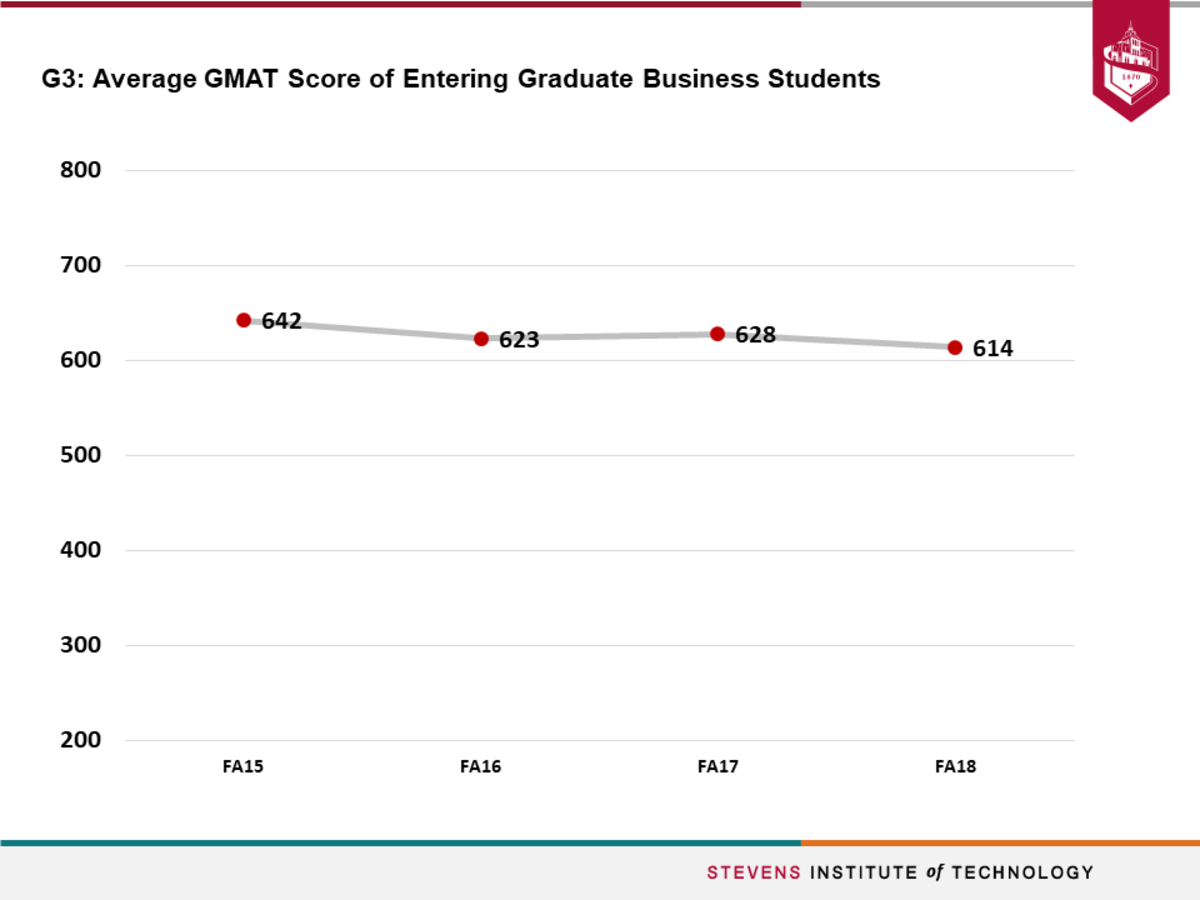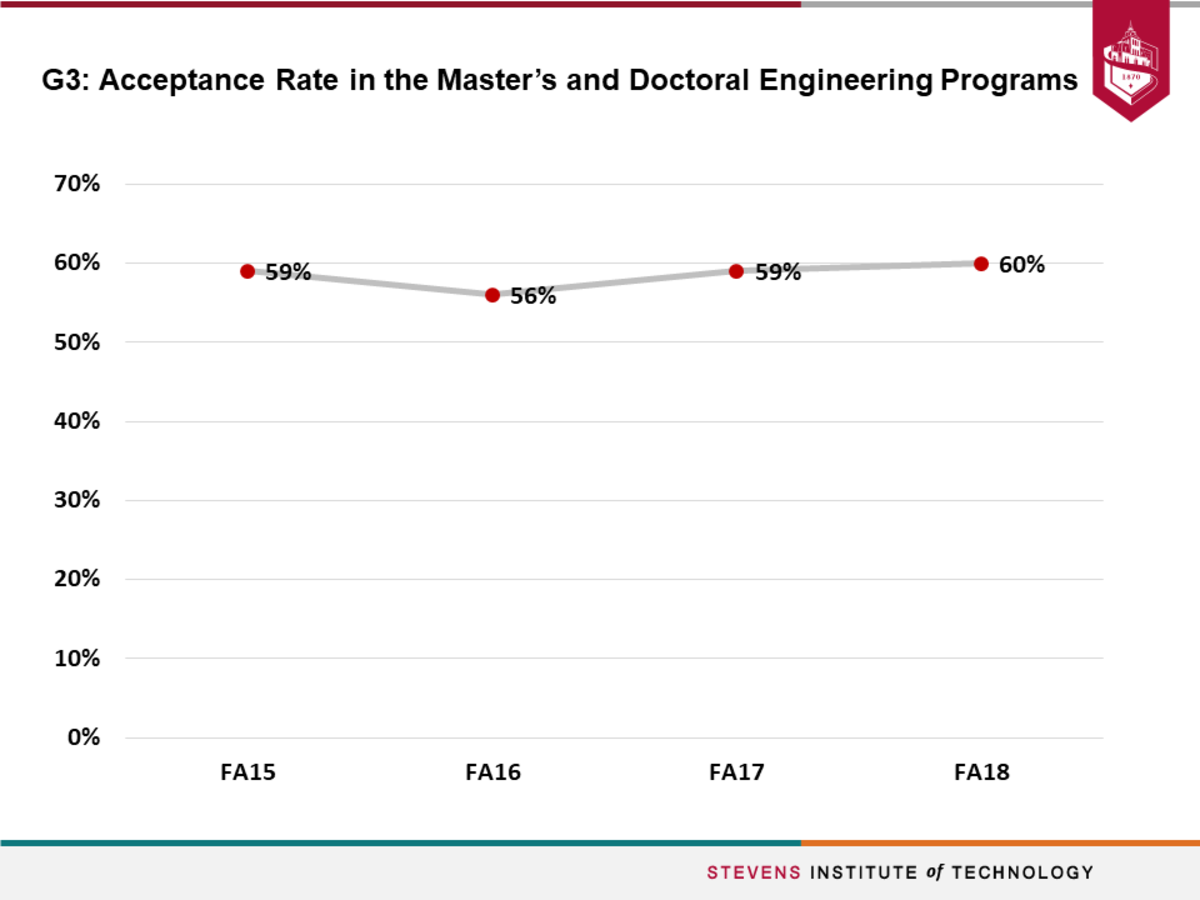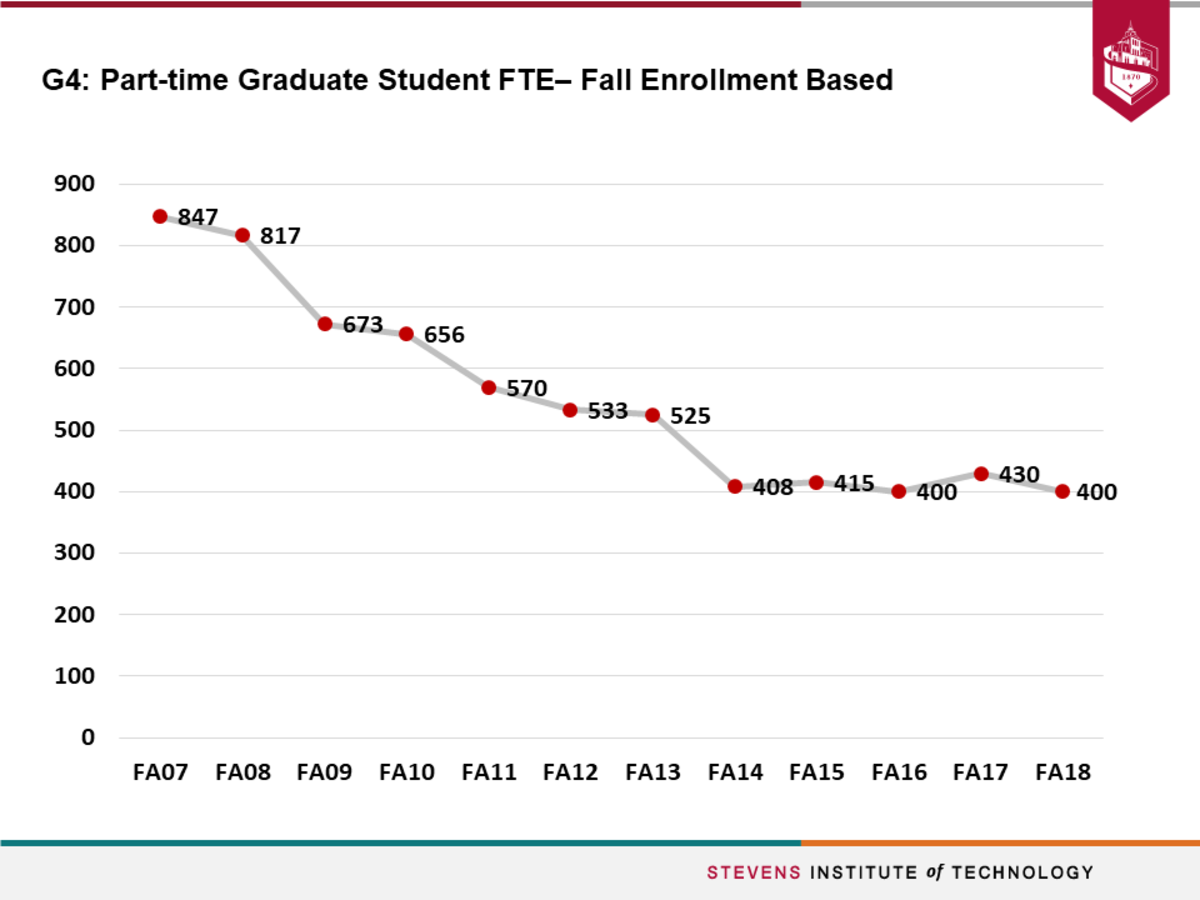After a period of significant growth, total graduate enrollment declined in Fall 2018 by 7.8% compared to Fall 2017, with total new graduate students declining by 18.3%, including StevensOnline and 23.1% excluding StevensOnline. While applications decreased only slightly, enrollment decreased across nearly all categories of students and Schools. Selectivity was 60% in Fall 2018 compared to 59% in Fall 2017, and the quantitative GRE scores for entering engineering graduate students remained stable at 161. A new administrative structure was put in place for graduate studies, and StevensOnline was launched. Numerous new initiatives to strengthen support and community for graduate students were launched.
Goal G1
We will develop a vibrant graduate studies enterprise, which critically enriches Stevens by contributing to our intellectual vitality and leading-edge research and scholarship, our financial profile, and our reputation for excellence. In so doing, we will offer a full slate of high-quality graduate programs, encompassing research, professional, and online opportunities. We will also encourage our undergraduates to pursue a Stevens graduate degree to prepare them for the rising demand in jobs requiring post-graduate degrees. We will ensure that graduate FTE enrollments grow by at least 3 percent annually with an overall FTE graduate enrollment of at least 3,025 by 2022. We will diversify the Stevens graduate student population by aggressively increasing the number of domestic students to no less than 25 percent FTE by 2022 and increasing the countries of origin of the graduate population with no more than 30 percent from a single country. We will align resources to achieve graduate enrollment goals and distribution of graduate students among graduate programs.
OWNER: PROVOST CHRISTOPHE PIERRE
Significant efforts took place in Year 6 to expand the graduate enterprise, with planning underway for additional graduate program offerings, development of the Accelerated Master’s Program to increase the number of Stevens undergraduates who pursue a graduate degree, and efforts to increase domestic graduate students. Results for Fall 2018 are below:
Graduate enrollment (overall headcount) fell to 3,498 in Fall 2018 from 3,793 in Fall 2017
For Fall 2018, the FTE enrollment corresponding to the strategic plan goal of 3,025 in 2022, is currently at 2,698
Over the last three years (through Fall 2018), domestic enrollments have slightly increased, now accounting for 26% of student FTE
In spite of a number of new initiatives to diversify the applicant pool and the cohort of newly enrolled graduate students, the percentage of graduate students from China has remained at 44%. At the same time, the percentage of graduate enrollment from countries other than China and India fell to 6% in Fall 2018 vs. 7% in Fall 2017.
Among the new initiatives implemented were the following:
Piloted Instant Decision Day events in India to boost applications in India
Increased applications by 20% or more from Nigeria, Bangladesh, Taiwan, Ghana, and Pakistan
Increased Provost Master’s Scholarships to $2 million with allocations provided by December 1 to allow for effective recruitment. There were 89 awarded in Fall 2017 and 131 awarded in Fall 2018.
Goal G2
We will grow a high-quality Ph.D. program to which we recruit students from the best institutions worldwide. To this end, we will implement competitive multi-year financial aid packages for Ph.D. students (particularly for research assistantships and fellowships) as well incentive programs for faculty, in order to ensure both retention and on-time graduation of Ph.D. students. By 2022, we will increase the ratio of full-time doctoral students to full-time tenured or tenure-track faculty in STEM fields to 3:1 and 1:1 in the School of Business, and the number of doctoral degrees granted each year to 70 by 2022 on the way to a steady-state of at least 110 doctoral degrees granted per year.
OWNER: PROVOST CHRISTOPHE PIERRE
The number of doctoral degrees awarded in AY17-18 was 52, representing a 7% decrease compared to AY16-17. The number of full-time doctoral students per full-time tenured/tenure-track engineering faculty was 2.4 in Fall 2018, an increase from 2.1 in Fall 2017. For the School of Business, the same ratio held steady at 1.2 over the same period.
Activities in support of this goal included:
A doctoral recruitment event attended by 48 top Ph.D. applicants nationwide and several international students yielded 37 admitted students and 24 acceptances. Of these, 17 received a Provost’s Doctoral Fellowship and seven received support from their department beginning in Fall 2018, for an overall yield of 65%.
Doctoral application and funding request deadlines were modified for Fall 2018. Following the Council of Graduate Schools preferred deadline, April 15 was designated as the deadline to accept financial awards.
The Provost’s Doctoral Recruitment Fellowship budget increased to $1.7 million in FY19 from $1.5 million in FY18. There were 30 new recipients of Provost’s Fellowships enrolled for Fall 2018.
Goal G3
We will systematically grow and deploy graduate studies programs with the aim of increasing Stevens’ standing in well-recognized rankings such as the U.S. News & World Report Best Graduate Schools rankings and the attendant metrics. We will aim for an average GRE Quantitative Score of 162 and a GMAT score of 610 for entering graduate students, and for an acceptance rate of 45 percent by 2022.
OWNER: PROVOST CHRISTOPHE PIERRE
The average quantitative GRE score for entering engineering graduate students held steady at 161 in Fall 2018. The average GMAT score for School of Business students enrolled in full-time master’s programs was 628 for Fall 2017 and 614 in Fall 2018. The acceptance rate for master’s and doctoral engineering students showed a slight increase from 59% in Fall 2017 to 60% in Fall 2018.
A number of additional activities, ranging from targeted email campaigns and promotional materials on funding opportunities to prospective students, application schedule adjustments, benchmarking graduate ranking metrics, and enhancing career placement support in the School of Business, were implemented during Year 6.
New initiatives undertaken to increase Stevens’ standing included:
Initiated proposal for new AI related programs (Applied AI, Machine Learning, Data Science) targeted at working professionals and online study
Accelerated Master’s Program (AMP) approved in Spring 2018 and currently being rolled out to current students in Fall 2018 with the initial freshman class to be invited to the program for Fall 2019
Set goal of 50% Stevens undergraduates to pursue graduate degree through the AMP
Goal G4
We will establish a cohesive, integrated, strategic and distinctive approach to continuing, corporate, professional and online graduate programs with the goal of broadening recognition of the Stevens brand nationally and internationally; enrolling students that Stevens would not otherwise attract; and strengthening partnerships with strategic corporations and industries. From a baseline of 316 part-time student FTEs in Fall 2016, we will increase part-time student FTEs to 450 by Fall 2022.
OWNER: PROVOST CHRISTOPHE PIERRE
StevensOnline was launched Fall 2017 with 17 master’s programs. Subsequently, the Office of Continuing, Professional and Online Education was created to organize the efforts of corporate, online, and professional programs under one Director.
As of Fall 2018, part-time graduate student FTE was 400. New program offerings, procedural improvements, and new and expanded marketing initiatives for StevensOnline are being implemented to increase enrollment.
Additional updates for Year 6 include:
Corporate student enrollment increased from 1,276 in FY17 to 1,350 in FY18. These numbers include students who are enrolled in all semesters during the academic year. FY18 Y-Term (corporate) enrollments decreased 1.2%; new cohorts were signed with Harris, Northrop Grumman, Lockheed Martin, and UTC for FY19.
WebCampus management moved to the Office of Graduate Studies to align all aspects of online programs.
StevensOnline launched 17 master’s programs (now 22 programs) and enrolled 89 new students in Fall 2018 compared to 27 in Fall 2017.
Goal G5
We will provide a best-in-class graduate student experience that supports our diverse graduate student population in all its dimensions. Based on benchmark data and student input, we will develop programs, spaces, policies, services and opportunities to ensure graduate students are recognized as and feel they are an important and valued constituency within the Stevens community. We will monitor and increase graduate placement rates, in particular, placement of Ph.D. students at academic institutions and research organizations of high reputation, as well as prestigious industry settings.
OWNER: PROVOST CHRISTOPHE PIERRE
Support and opportunities for graduate students have increased over the past year. Mentoring programs for master’s students have been reviewed to determine the best model for the graduate population. Implementation of the program will begin in the Spring 2019 semester with onboarding of Orientation Leaders/Peer Mentors, including preparation for the incoming Fall 2019 class of Master’s Students. The Graduate Enrichment Series was restructured to focus on skills-based training. Sessions and workshops are now available online as a CANVAS course. Attendance has increased from 478 participants in AY 16-17 to 860 participants in AY 17-18.
Also, in collaboration with the Office of Information Technology, graduate students may access Lynda.com, which provides competency-based online training. The 2018 Graduate Research Conference was held in February 2018, organized by a committee of five graduate students and six faculty members. Twenty oral presentations were given by graduate students and two students were awarded conference funding to present at national conferences. Through working with the Graduate Student Council, Student Club Organizations, and the Master’s Advisory Board, the need for academic support services and support matter experts has been largely addressed. Now, many academically-based student organizations are incorporating peer study groups into their semester programming to address specific student needs.
New methods have been developed to track doctoral student progress from the start of their program through graduation. These include: mid-semester check-ins and the creation of the Doctoral Student Professional Development Plan, designed to assist students with personal and professional goals and meeting program milestones. An exit survey capturing post-graduation information was distributed to graduating doctoral students to track placement of Ph.D. students. A comprehensive co-curricular support program that addresses career preparation, teaching, and writing was also designed and implemented. This includes a Ph.D. Student Road Map that outlines suggested areas of focus for each year of the doctoral program, along with the introduction of new programs such as doctoral student training, teaching circles, career panels, academic job search programs, conference preparation series, and Ph.D. peer mentoring

